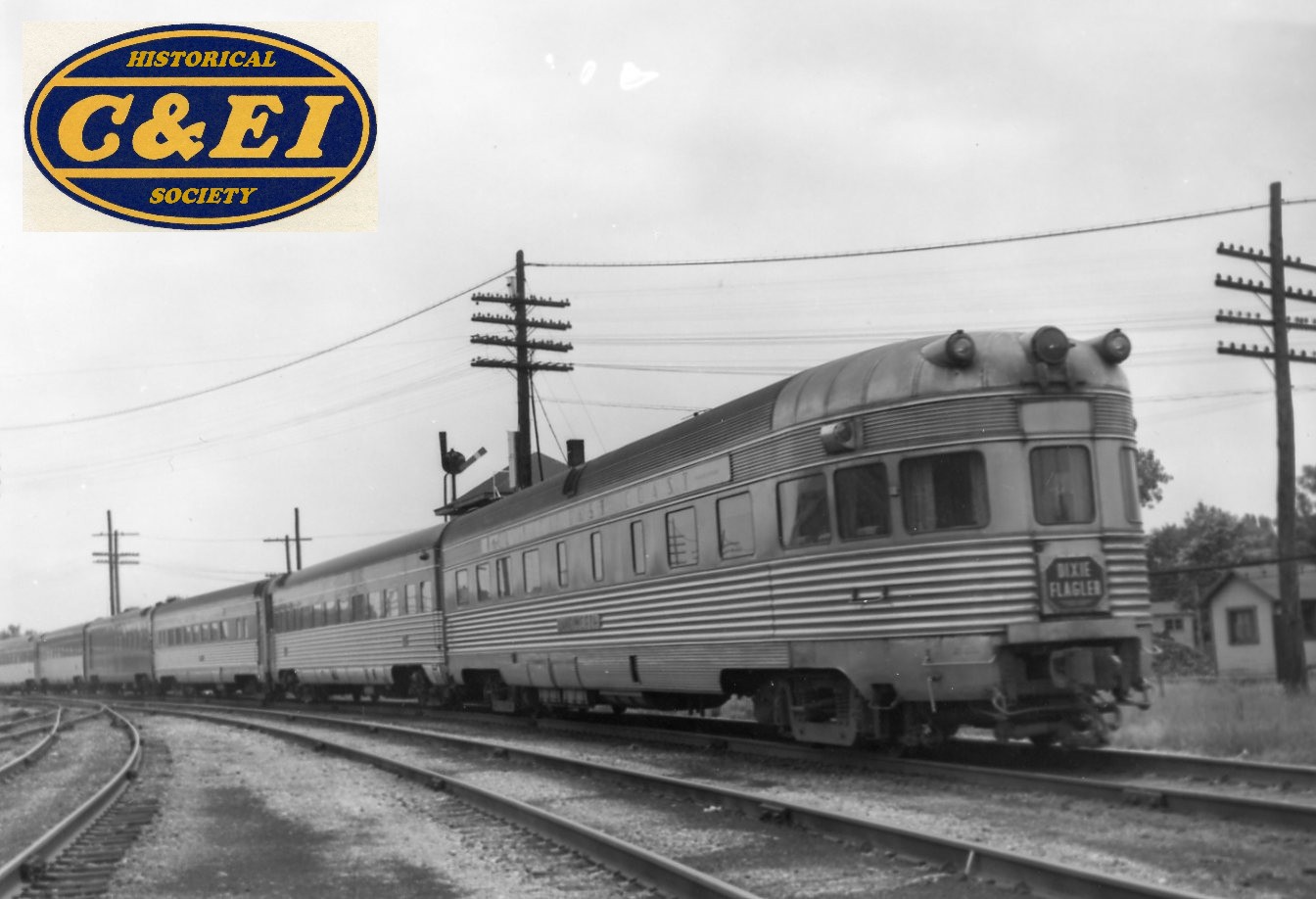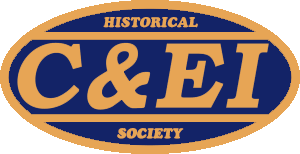
C&EI Railroad History
From the Early Days to Modern Legacy
From the Early Days to Modern Legacy.
The Chicago and Eastern Illinois Railroad (C&EI) Chicago to Evansville line was created from the consolidation of three railroads, the earliest of these roads dating to January 2, 1849, when the Evansville and Illinois Railroad was chartered to operate between Evansville and Vincennes, IN. The three roads were:
- Chicago, Danville & Vincennes (November 1871): Connecting Chicago and Danville.
- Evansville, Terre Haute & Chicago (October 1871): Serving the Danville to Terre Haute route.
- Evansville & Terre Haute (November 1854): Covering the Terre Haute to Evansville stretch.
Although passenger service was provided over the three roads between Chicago and Evansville almost immediately, the process of consolidating the operations of the three roads was slow. The C&EI name dates to March 8, 1881, and from this point in time, the C&EI exercised some financial control over the Chicago‑Evansville line. But complete consolidation of the properties was not accomplished until July 20, 1911. Also, in the 1890s, the Chicago and Indiana Coal Railroad entered the C&EI fold, giving the C&EI a secondary mainline between LaCrosse, Indiana and Evansville. (A connection was made at Momence between the two mainlines.)
Growth and Economic Impact
The basis for C&EI growth was coal. Coal from mines in central Illinois and central western Indiana was moved by the railroad to Chicago as fuel for heating the city. The C&EI’s growth was strongly associated with the growth of Chicago. At the same time, the C&EI was developing itself as a bridge‑route between the southern states and Chicago. In the longer run, as the demand for coal dwindled, bridge traffic would prove more economically important to the road.
Expansion and Challenges
In the early 1890s, the road began building south into southern Illinois. By 1900, the C&EI extended to Thebes, Illinois on the Mississippi River where a ferry connection with the Cotton Belt was begun. In 1904, the C&EI began operating Chicago‑Saint Louis passenger service through trackage rights over the CCC&StL (NYC) from Findlay Jct., Illinois to Saint Louis.
Then, the C&EI and Cotton Belt spearheaded the construction of the Thebes Bridge. For the C&EI, the strategic fallout of this action was tremendous. The Frisco, threatened by the alliance of the C&EI and Cotton Belt, proceeded to take over the C&EI on October 1, 1902. This ended the expansion of the C&EI. The bridge itself was completed on April 1, 1905.
For the next eight years, Frisco exploited the C&EI through exorbitant dividend demands, and the rental of C&EI equipment at below‑market rates. When Frisco entered bankruptcy in 1913, so did the C&EI. The C&EI physical plant was in poor condition following the Frisco. Frisco control also had another effect on the C&EI: it gave the C&EI steam power its handsome Frisco‑like appearance.
Modernization and Merger
During World War I the C&EI like other railroads, fell under control of the government. During this time the C&EI traffic boomed, but the C&EI remained in receivership until January 1, 1922. When the C&EI was returned to private hands, the secondary Indiana line was spun off as the Chicago, Attica & Southern. The ill‑fated CA&S was mostly abandoned by 1946.
During the 1930s, Chesapeake & Ohio began to buy up C&EI stock, never exercising any significant control over the road it seems. In any case, because of the depression, the C&EI again entered receivership in 1933, but was back in private hands again at the end of 1940. World War II brought prosperity to the property, and in the immediate war years the C&EI modernized rapidly. For example, the road was entirely dieselized in May 1950, making it the first dieselized road with more than 1000 miles of track. But modernization was not enough to assure survival; with mergers taking place all around it, the C&EI found its traffic drying up. The C&EI needed to merge too.
Legacy
Various merger offers were explored, and again, it was a southwest road that found itself threatened by these overtures. In 1961 the Missouri Pacific began secretly (and illegally) buying C&EI stock. When the Missouri Pacific requested ICC permission to takeover the C&EI, the federal agency turned a blind eye to the illegalities; approved the takeover of the C&EI with the stipulation that the Evansville line be sold to the L&N; and effectively deprived C&EI’s other stockholders of stock profits. In short, Missouri Pacific got the C&EI for cheap.
On May 12, 1967, the Missouri Pacific assumed control of the C&EI. And, on June 6, 1969, Louisville & Nashville purchased the 206-mile Woodland Junction to Evansville leg along with joint trackage rights from Woodland to Chicago. On October 15, 1976, what remained of the C&EI was merged into Missouri Pacific, which was later absorbed by the Union Pacific.
Today, ex‑C&EI trackage is used by the Union Pacific (ex‑Missouri Pacific) from Southern Illinois and St Louis to Woodland Junction and by CSX (ex‑L&N), from Evansville, Indiana to Woodland Junction. CP Rail also had trackage rights on part of CSX from Terre Haute, Indiana to Chicago with their acquisition of the Soo Line (former Milwaukee rights). The heavily used line from Chicago to Woodland Junction, a double track mainline, is maintained and dispatched by the Union Pacific under a joint agreement with CSX. This double track section is well worth a visit..
The C&EI in the 1945-1960 Era
Physical Plant:
- Most rail was 115 lb. Secondary main lines were generally 90 lb. wait. South of Salem, Illinois rail was 90 lb. Ballast was slag, crushed stone, or gravel for the 800 miles of mainline; cinders for the sidings and yards. The track was in top shape everywhere.
Major Yards:
- Yard Center (two humps), Dolton, IL; Brewer Yard, Danville, IL; Wansford Yard (new in 1950), Evansville, IN; Alice Yard, Terre Haute, IL; Villa Grove Yard, Villa Grove, IL; Mitchell Yard, East Saint Louis, IL; Salem Yard, Salem, IL.
Signaling:
- Until 1952, all C&EI trains on the Chicago‑Danville line were controlled by Miller Train Control. In fact, the C&EI pioneered this train control system. CTC (centralized traffic control) was in operation between Clinton and Evansville, Indiana. In the early 1960’s the mainline from Clinton to Woodland Junction was converted to CTC and much of the second track removed with sidings placed about every 10 miles. The dispatcher’s office was in Danville. An improved manual block was in operation between Findlay Junction and Pana, Illinois with all turnouts interlocked and controlled from Findlay Junction.
Main Shops:
- The C&EI main shops were Oaklawn on the east side of Danville, Illinois. They were medium sized but well‑maintained and modern. Most structures dated from the early 1900s, except the paint shop. Facilities for work on locomotives were accessed via a transfer table. The C&EI built many of its own boxcars, hoppers, and cabooses here. The diesel shop was one of the best in the country. After the sale of the mainline to the Louisville and Nashville Railroad, and locomotive shop at Oaklawn closed, the buildings were leased to Danville Industries and later to freight car builder Johnstown America.
Traffic:
- Coal: Bituminous coal was the largest volume item for the C&EI constituting about one‑third of all traffic. In early years it supplied coal to the Chicago area and later to rail to water transfer and power plants in Indiana.
- Bridge Traffic: A significant portion of freight revenue came from interchanging with other railroads, including Louisville & Nashville and Missouri Pacific.
Roundhouses:
- Small roundhouses were maintained at: Yard Center (Dolton, IL); Chicago Heights (CHTT); Villa Grove, IL; Salem, IL; Terre Haute, IN; and Evansville, IN. These roundhouses were used to make running repairs on switch engines, also for the inspection of road units.
Interchange:
- Because of the C&EI’s numerous connections, bridge traffic was a major source of revenue. More than half of all freight was for interchange, primarily the Louisville and Nashville in Evansville, the Missouri Pacific and western carriers in St. Louis, the Wabash in Danville and numerous carriers in the Chicago area through the Belt Yard and other connections. The IC, NYC, NKP, and PRR were major connections away from the larger cities.
